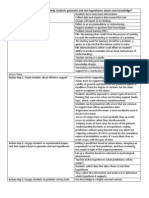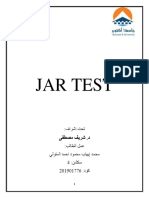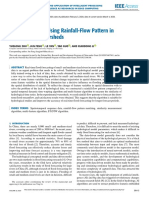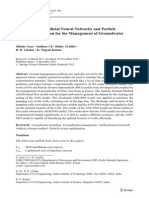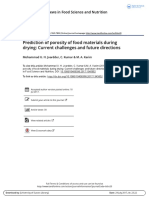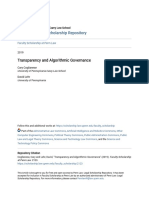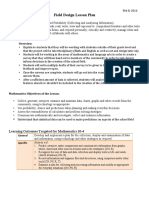Parameterization and Parameter Estimation of Distributed Models
Parameterization and Parameter Estimation of Distributed Models
Uploaded by
mat506615Copyright:
Available Formats
Parameterization and Parameter Estimation of Distributed Models
Parameterization and Parameter Estimation of Distributed Models
Uploaded by
mat506615Original Title
Copyright
Available Formats
Share this document
Did you find this document useful?
Is this content inappropriate?
Copyright:
Available Formats
Parameterization and Parameter Estimation of Distributed Models
Parameterization and Parameter Estimation of Distributed Models
Uploaded by
mat506615Copyright:
Available Formats
PARAMETERIZATION AND PARAMETER ESTIMATION OF DISTRIBUTED MODELS
PROGRESS REPORT FOR PROJECT NUMBER NA04NWS4620012 Covers the Period 12/01/06 TO 05/31/2007 Submitted August 13, 2007 TITLE: PI: Co-PI: Parameterization and Parameter Estimation of Distributed Models For Flash Flood and River Prediction Hoshin V. Gupta1, Professor Thorsten Wagener2, Assistant Professor 1 Department of Hydrology and Water Resources, The University of Arizona, Tucson, Arizona, 85721, Tel: 520-626-6974 2 Now at Department of Civil and Environmental Engineering, Penn State Univ., University Park, PA 16802, Tel: 814-865-5673
1. PROJECT OBJECTIVES AND ACCOMPLISHMENTS 1.1. Project Objectives The shift from lumped to distributed models raises many important questions about the proper choice of model parameterization, including the desirable level of model complexity, while significantly increasing the complexity of the parameter estimation problem. The main objective of this project is to collaborate with and support the Hydrologic Modeling team at the NWS Office of Hydrology in the rapid development of an advanced version of the NWS-OH distributed hydrologic model, with particular attention to the issues of parameter estimation, appropriate model structure, supportable model complexity, and model evaluation, diagnosis and improvement. The unifying theme through this proposal is to focus on improving distributed watershed modeling through addressing issues of model parameterization (specification of model components), and estimation of the model parameters in both gauged and ungauged settings. The following tasks were listed under this contract: 1. Parameterization of semi-distributed and distributed hydrologic models within Hydrology Laboratory-Research Modeling System (HL-RMS) framework, 2. Distributed parameter estimation (automated and/or semi-automated) for the above (this work will build on our experience with lumped models, while introducing novel ideas such as regularization that are specifically tailored to distributed models), 3. A priori methods for parameter estimation in ungauged basins using direct inference from watershed properties and statistical regression analysis (existing work by NWS-HL staff will be extended and used to drive this important area of hydrologic modeling research forward). This work extends our past collaborative work with the NWS by supporting the development of distributed modeling capabilities with particular attention given to ungauged and poorly gauged watersheds, consistent with the aims and future directions of the NWS. This research is being implemented in the context of the HL-RMS thereby
PARAMETERIZATION AND PARAMETER ESTIMATION OF DISTRIBUTED MODELS
maximizing technology transfer and ensuring that the work outcome is of direct value to the NWS. 1.2. Summary of Work Proposed a. Implement HL-RMS at the University of Arizona as a modeling environment. Incorporate currently available calibration algorithms. b. Investigate and implement a distributed parameter estimation algorithm based on the concept of regularization c. Investigate the a priori parameter estimation problem using both bottom-up (incl. the development of relationships between the parameters of the NWS conceptual model components to soil and watershed characteristics) and top-down (regionalization) approaches. d. Testing of various modifications of the HL-RMS including the comparison to semi-arid specific models. e. Combining the research on a priori and distributed parameter estimation into a single procedure. f. Testing the basic equations relating model parameters and watershed properties in a multi-watershed study. Complementing this approach with a statistical regionalisation approach using a minimum of 30 watersheds. g. Implementing and testing various ensemble-forecasting schemes. h. Technology transfer through (in person and telephone) meetings. i. Implementing and testing the new tools for a priori and distributed parameter estimation into the HL-RMS. j. Extending the Bayesian recursive scheme from lumped to distributed model structures. k. Continue work on ensemble forecasting schemes. l. Technology transfer through (in person and telephone) meetings. 1.3. Project Accomplishments During Progress Report Period (12/01/2006 - 05/31/2007) Our activities during last six months focused on: a) improving the strategy for diagnostic evaluation of HL-DHMS model, b) extending the regionalization approach introduced by Yadav et al. (2007) to identify behavioral parameter sets. a) The diagnostic model evaluation strategy was extended to detect streamflow timing errors in the HL-DHMS model predictions. The HL-DHMS model parameterized by Koren a priori parameterization scheme (Koren et al., 2000) was used as a baseline model to benchmark the model performance improvements obtained by diagnostic model evaluation strategy. Upon reviewing the timing measures commonly used in the hydrologic literature, two flow timing measures were formulated: an event-based measure and an overall time period measure. Eventbased measure is based on isolating representative flow events from a hydrograph. Each flow event is then partitioned into rising and falling segments and time location of flow
PARAMETERIZATION AND PARAMETER ESTIMATION OF DISTRIBUTED MODELS
centroid is calculated for each segment. One-at-a-time and random sampling based parameter perturbations were performed to isolate the parameters affecting the time location of simulated flow centroid of the rising limb (signature measure for flow timing). Overall, the perturbation analysis results revealed that UZFWM and ROUTQ0 (specific discharge parameter of the channel routing model) are the dominant parameters controlling the timing of flow in HL-DHMS model. Note that all routing model parameters, except ROUTQ0, were fixed at their a priori values. Another timing measure based on processing of rainfall (mean areal rainfall) and streamflow observations for overall time period was formulated. The goal was to estimate, in a simple way, the intrinsic time-lag of the watershed. In the procedure, the time-shift (hours) providing the maximum correlation between mean areal rainfall and streamflow time series was selected as time-lag of the watershed. In this manner, time-lag can be calculated for flows above a threshold value. Parameter perturbation analysis revealed that UZFWM and ROUTQ0 are the dominant parameters controlling time-lag of the watershed, and hence supported the findings from event-based flow timing analysis. Future work will focus on HL-DHMS model deficiencies caused by incorrect spatial distribution of parameters. b) The new regionalization approach introduced by Yadav et al. (2007) was extended to include a global multi-objective optimization approach to identify behavioral parameter sets. Yadav et al. (2007) showed that regionalized indices of watershed response characteristics (e.g. runoff ratio) can be used to considerably reduce the uncertainty in ensemble streamflow predictions at ungauged locations. Indices of hydrologic response were regressed against physical and climatic watershed characteristics including uncertainty. The regression thus provides ranges for response indices at ungauged locations and models (parameter sets) not producing indices within these ranges can be eliminated as unacceptable from ensemble forecasts. One drawback of the proposed strategy was, however, that a very inefficient Monte Carlo approach was used to identify acceptable parameter sets. This limited the approach to very few indices that could be used simultaneously, and to simple watershed model structures. We recently reformulated the problem of finding acceptable parameter sets as a multi-objective optimization problem and solved it using a evolutionary genetic algorithm. Running the algorithm on a parallel cluster, we showed that for 30,000 function evaluations a relatively consistent population of about 10,000 acceptable parameter sets could be found. This improvement to the approach will now allow us to test it on spatially explicit watershed models such as the HL-DHMS.
2. SUMMARY OF RESEARCH AND EDUCATIONAL EXCHANGES Scientific exchanges between UA/PSU researchers and NWS-HL personnel have taken place in the form of phone calls and e-mails. The research performed for this project was incorporated into the DMIP-2 experiment organized by the NWS Hydrology Laboratory. Victor Koren, Mike Smith and Zhengtao Cui of HL provided technical assistance for HL-DHMS model.
PARAMETERIZATION AND PARAMETER ESTIMATION OF DISTRIBUTED MODELS
3. PRESENTATIONS AND PUBLICATIONS
Pokhrel, P, Estimation of Spatially Distributed Model Parameters Using a Regularization Approach, MS Thesis, Univ. of Arizona, April 2007. Reed, P.M., Tang, Y., *Werkhoven, K. van and Wagener, T. 2007. Using Global Sensitivity Analysis to Better Understand How Real-Time Observations Influence Operational Flood Forecasts in the Susquehanna River Basin. ASCE World Water and Environmental Resources Congress, Tampa, Florida, May 2007. (Oral) Reed, P.M., Tang, Y., Van Werkhoven, K. and Wagener, T. 2007. Using global sensitivity analysis to better understand how real-time observations influence operational flood forecasts in the Susquehanna River Basin. Association of Environmental Engineering and Science Professors, Blacksburg, Virginia July 2007. (Poster) Tang, Y., Reed, P., Van Werkhoven, K. and Wagener, T. 2007. Advancing the identification and evaluation of distributed rainfall-runoff models using global sensitivity analysis. Water Resources Research, 43, doi:10.1029/2006WR005813. Tang, Y., Reed, P., Wagener, T. and Van Werkhoven, K. 2007. Comparing sensitivity analysis methods to advance lumped watershed model identification and evaluation. Hydrology and Earth System Sciences, 11, 793-817. Van Werkhoeven, K., Wagener, T., Reed, P. and Tang, Y. 2007. Sensitivity analysis of a distributed hydrologic model for uncertainty reduction and identification of dominant model controls. 14th IUGG General Assembly, Perugia, Italy, 2-13th July 2007. (Poster) Van Werkhoven, K., Wagener, T., Tang, Y., and Reed, P. Understanding watershed model behavior across hydro-climatic gradients using global sensitivity analysis. Water Resources Research. (Pending Minor Revisions) Wagener, T., Gupta, H.V., Yilmaz, K. and Yadav, M. 2007. Evaluation of hydrologic models in ungauged basins using regionalized watershed response characteristics. 14th IUGG General Assembly, Perugia, Italy, 2-13th July 2007. (Oral) Wagener, T., Reed, P., *Werkhoven, K. van and Tang, Y. 2007. Identification and evaluation of complex environmental systems models using global sensitivity analysis and evolutionary multiobjective optimization. International Workshop on Advances in Hydroinformatics (HIW07), Niagara Falls, Canada, June 4-7th 2007. (Invited Keynote) Yadav, M., Wagener, T. and Gupta, H.V. 2007. Regionalization of constraints on expected watershed response behavior for improved predictions in ungauged
PARAMETERIZATION AND PARAMETER ESTIMATION OF DISTRIBUTED MODELS
basins. Advances in Water doi:10.1016/j.advwatres.2007.01.005.
Resources,
30(8),
1756-1774.
Yilmaz, K., and H.V. Gupta, Towards improved modeling for ungauged and poorly gauged basins: Presented at Middle East Technical University, Ankara, Turkey, June 29, 2007 (Invited Talk) Yilmaz, K., H.V. Gupta and T. Wagener, Diagnostic Evaluation of a Distributed Watershed Model: A Process-based Approach, Presented at the IUGG General Assembly, Perugia, Italy, July 913, 2007 (Oral) Yilmaz, K., K., 2007. Towards improved modeling for hydrologic predictions in poorly gauged basins, Ph.D. Dissertation, Univ. of Arizona.
4. FUTURE WORK In the light of the experience we have gathered from the above analysis, the following studies will be performed: a) Measures that are powerful in diagnosing HL-DHMS model inadequacies will be further researched. b) Parallel processing techniques developed at the Penn State University will be implemented at the University of Arizona to perform faster model runs required by the optimization algorithms. c) Implementation of regionalization approach in US watersheds. d) Connecting sensitivity analysis and model calibration in combined procedure.
5. SUMMARY OF BENEFITS AND PROBLEMS ENCOUNTERED Benefits that have been experienced during the last year a. UA/PSU researchers are becoming familiar with the HL-DHMS distributed hydrologic model developed by NWS-HL in an effort to contribute and share new ideas. Students are becoming familiar with NWS software, methods and procedures. b. Project provided research subjects for two master theses (Prafulla Pokhrel, Univ. of Arizona & Maitreya Yadav, PSU) and in part a Ph.D. dissertation (Koray K. Yilmaz, Univ. of Arizona). Sub-projects have been derived from this project for
PARAMETERIZATION AND PARAMETER ESTIMATION OF DISTRIBUTED MODELS
elements of the PhD dissertations by Yong Tang and Katie van Werkhoven (PSU). c. Fruitful communication between UA/PSU researchers and HL personnel has continued. Problems encountered a. No significant problems were encountered during the last 6 months.
6. REFERENCES Koren, V. I., Smith, M., Wang, D. and Zhang, Z. (2000). Use of soil property data in the derivation of conceptual rainfall-runoff model parameters. 15th Conference on Hydrology, Long Beach, American Meteorological Society, Paper 2.16, USA.
You might also like
- Chapter 4 MarzanoDocument2 pagesChapter 4 MarzanoJocelyn Alejandra Moreno GomezNo ratings yet
- Predicting Football Matches Using Neural Networks in MATLABDocument6 pagesPredicting Football Matches Using Neural Networks in MATLABDiego PovedaNo ratings yet
- Alternative Methodology To Avoid Convergence Problems Caused For WELDRAW KeywordDocument3 pagesAlternative Methodology To Avoid Convergence Problems Caused For WELDRAW Keywordmanish.7417No ratings yet
- R - R ModelsDocument24 pagesR - R ModelsBijay Kumar RegmiNo ratings yet
- A New Tool For Automatic Calibration of Storm Water Management ModelDocument9 pagesA New Tool For Automatic Calibration of Storm Water Management Model吳彥摩 WU,YEN-MO N86114059No ratings yet
- Lange and Sippel MachineLearning HydrologyDocument26 pagesLange and Sippel MachineLearning HydrologyAvadhoot DateNo ratings yet
- Environmental Modelling & Software: F.T. Andrews, B.F.W. Croke, A.J. JakemanDocument15 pagesEnvironmental Modelling & Software: F.T. Andrews, B.F.W. Croke, A.J. JakemanAndrea GarciaNo ratings yet
- Chapter 3 - 090718Document5 pagesChapter 3 - 090718mascottony3No ratings yet
- Modeling Sediment YieldDocument13 pagesModeling Sediment YieldisholaoladimejiNo ratings yet
- Bai 2016Document14 pagesBai 201688448989No ratings yet
- Bjerre Et Al. - 2022 - Assessing Spatial Transferability of A Random ForeDocument11 pagesBjerre Et Al. - 2022 - Assessing Spatial Transferability of A Random ForeMichael Diego Lizarazu RojasNo ratings yet
- Water 15 01265Document19 pagesWater 15 01265xavanelliNo ratings yet
- Task 6 of AiDocument5 pagesTask 6 of Aimuhammadmoizrasheed511No ratings yet
- Can Machine Learning and Predictor Selection Algorithms Yield Reliable Stream Flow Prediction?Document10 pagesCan Machine Learning and Predictor Selection Algorithms Yield Reliable Stream Flow Prediction?malaya_mohantyNo ratings yet
- Basic Guidelines For Groundwater Modelling Studies: C. P. KumarDocument13 pagesBasic Guidelines For Groundwater Modelling Studies: C. P. Kumarayaz hasanNo ratings yet
- Report UADAT Phase II PDFDocument45 pagesReport UADAT Phase II PDFAriel VargasNo ratings yet
- A Spatio-Temporal Predictive Learning Model For Efficient Sea Surface Temperature ForecastingDocument19 pagesA Spatio-Temporal Predictive Learning Model For Efficient Sea Surface Temperature Forecastingsela.nitzNo ratings yet
- AdeyeriDocument15 pagesAdeyerijme250047No ratings yet
- Study On Threshold Selection Methods in CalculatioDocument13 pagesStudy On Threshold Selection Methods in CalculatioSarah AnindiyaNo ratings yet
- Exploiting Capacity of Sewer System Using Unsupervised Learning Algorithms Combined With Dimensionality ReductionDocument29 pagesExploiting Capacity of Sewer System Using Unsupervised Learning Algorithms Combined With Dimensionality ReductionBrenner Biasi SilvaNo ratings yet
- Multi-Step-Ahead Prediction of River Flow Using NARX Neural Networks and Deep Learning LSTMDocument18 pagesMulti-Step-Ahead Prediction of River Flow Using NARX Neural Networks and Deep Learning LSTMnqfaqNo ratings yet
- Rain - Bias - Hess 17 4379 2013Document10 pagesRain - Bias - Hess 17 4379 2013mfgobbi4515No ratings yet
- Matlab CodeDocument10 pagesMatlab Codesoheilvb6No ratings yet
- 120694-Article Text-332189-1-10-20150806Document12 pages120694-Article Text-332189-1-10-20150806DigvijayNo ratings yet
- Beylich, Haberlandt, Reinstorf - 2021 - Daily vs. Hourly Simulation For Estimating Future Flood Peaks in Mesoscale CatchmentsDocument13 pagesBeylich, Haberlandt, Reinstorf - 2021 - Daily vs. Hourly Simulation For Estimating Future Flood Peaks in Mesoscale CatchmentsChaitanya J CNo ratings yet
- ESDRERRSelectionsDocument18 pagesESDRERRSelectionsKoert OosterhuisNo ratings yet
- Research Statement DjimadoumngarDocument2 pagesResearch Statement Djimadoumngarapi-3839684660% (1)
- Simulation of Multiple Hydropower Reservoir Operations Using System Dynamics ApproachDocument22 pagesSimulation of Multiple Hydropower Reservoir Operations Using System Dynamics Approachreachyourdreams30No ratings yet
- Environmental Modelling & Software: Yaoling Bai, Thorsten Wagener, Patrick ReedDocument16 pagesEnvironmental Modelling & Software: Yaoling Bai, Thorsten Wagener, Patrick ReedAndrea GarciaNo ratings yet
- Literature Study On Application of HEC HDocument3 pagesLiterature Study On Application of HEC HPinninti PavanNo ratings yet
- Acgeo 2015 0070Document31 pagesAcgeo 2015 0070automate.tksNo ratings yet
- Docu 13Document14 pagesDocu 13Franco CernaNo ratings yet
- 1 s2.0 S1364815221002772 MainDocument14 pages1 s2.0 S1364815221002772 MainSecretSanta HYDR 2021No ratings yet
- Lab No 9 HydrologyDocument10 pagesLab No 9 HydrologyAzmat NaseemNo ratings yet
- R en La Modelacion HidrologicaDocument5 pagesR en La Modelacion HidrologicaDaniel MoralesNo ratings yet
- Wavelet Based ForecastingDocument11 pagesWavelet Based ForecastingBibhuti Bhusan SahooNo ratings yet
- 2018 WR 024461Document15 pages2018 WR 024461Rohit MishraNo ratings yet
- Chapter 1:introduction To Hec-HMSDocument8 pagesChapter 1:introduction To Hec-HMSSaurav MukherjeeNo ratings yet
- Richards Et Al (2010) - Using Generalized Additive Models To Assess, Explore and Unify Environmental Monitoring DatasetsDocument9 pagesRichards Et Al (2010) - Using Generalized Additive Models To Assess, Explore and Unify Environmental Monitoring DatasetsSuryoKusumoNo ratings yet
- Prediction Article - ScientificDocument12 pagesPrediction Article - Scientificsela.nitzNo ratings yet
- WRE 404 Lab - Lec1 To Lec6Document22 pagesWRE 404 Lab - Lec1 To Lec6ShahAfzalSakiNo ratings yet
- Water: Regionalization of SWAT Model Parameters For Use in Ungauged WatershedsDocument23 pagesWater: Regionalization of SWAT Model Parameters For Use in Ungauged WatershedsBernard OwusuNo ratings yet
- Hydropower Optimization Using Deep Learning: (Ole - Granmo, Jivitesh - Sharma) @uia - NoDocument13 pagesHydropower Optimization Using Deep Learning: (Ole - Granmo, Jivitesh - Sharma) @uia - Nojorge jorgeNo ratings yet
- DMIP 2 West Final 2013 - Journal of HydrologyDocument31 pagesDMIP 2 West Final 2013 - Journal of HydrologyidrologiaeambienteNo ratings yet
- Balance Hidrico-CapeFear Carolina Del NorteDocument15 pagesBalance Hidrico-CapeFear Carolina Del NortedanyalejandrahernandezmunozNo ratings yet
- Brighent Et Al 2019 Eco Eng SWATDocument11 pagesBrighent Et Al 2019 Eco Eng SWATFrancis-marie colson BeniambieNo ratings yet
- Assignment No. 5Document13 pagesAssignment No. 5RizwanAkbarNo ratings yet
- Modelling Rainfall-Runoff Using Genetic Programming: A A Set ADocument15 pagesModelling Rainfall-Runoff Using Genetic Programming: A A Set AGebeleizis MorbiduNo ratings yet
- Experimental Design For Estimating Parameters of Rate-Limited Mass Transfer: Analysis of Stream Tracer StudiesDocument11 pagesExperimental Design For Estimating Parameters of Rate-Limited Mass Transfer: Analysis of Stream Tracer Studieso_muratkazinovNo ratings yet
- 1 s2.0 S221501612300153X MainDocument22 pages1 s2.0 S221501612300153X MainYusrinnatul JinanaNo ratings yet
- Deep Learning Based Adjusted Forecasting Window Scale For Streamflow ForecastingDocument20 pagesDeep Learning Based Adjusted Forecasting Window Scale For Streamflow ForecastingZAHER MUNDHER YASEENNo ratings yet
- Jar TestDocument14 pagesJar TestMohamed EhabNo ratings yet
- Flood Prediction Using Rainfall-Flow Pattern in Data-Sparse WatershedsDocument12 pagesFlood Prediction Using Rainfall-Flow Pattern in Data-Sparse WatershedsSanjeeva Yedavalli100% (1)
- Ann-Pso Aem DoreDocument15 pagesAnn-Pso Aem DoreSan ChinNo ratings yet
- Rainfall-Runoff Modelling Using Fuzzy Technique For A Small Watershed in Maharashtra, IndiaDocument8 pagesRainfall-Runoff Modelling Using Fuzzy Technique For A Small Watershed in Maharashtra, IndiaRockstarNo ratings yet
- 1 s2.0 S136481522400286X MainDocument15 pages1 s2.0 S136481522400286X MainNimet KarabacakNo ratings yet
- s44290-024-00084-wDocument12 pagess44290-024-00084-wroshan.archisoftdesignNo ratings yet
- Path I Raja 2016Document23 pagesPath I Raja 2016jasleen kaurNo ratings yet
- Optimal Sizing of Rainwater Harvesting Systems ForDocument30 pagesOptimal Sizing of Rainwater Harvesting Systems ForLuke augustusNo ratings yet
- Hydro-Informatics Methods For Groundwater Simulation-Nastaran ZamaniDocument13 pagesHydro-Informatics Methods For Groundwater Simulation-Nastaran Zamanicopdeposu2071No ratings yet
- Research Article: Multivariate Streamflow Simulation Using Hybrid Deep Learning ModelsDocument16 pagesResearch Article: Multivariate Streamflow Simulation Using Hybrid Deep Learning ModelsHaile SolomonNo ratings yet
- Mesoscale Modelling for Meteorological and Air Pollution ApplicationsFrom EverandMesoscale Modelling for Meteorological and Air Pollution ApplicationsNo ratings yet
- A New Key Performance Indicator Model For Demand Forecasting in Inventory Management Considering Supply Chain Reliability and SeasonalityDocument15 pagesA New Key Performance Indicator Model For Demand Forecasting in Inventory Management Considering Supply Chain Reliability and SeasonalityHamza PervaizNo ratings yet
- Judgmental ForecastingDocument32 pagesJudgmental ForecastingAltafHussainNo ratings yet
- Don't Worry About ThisDocument124 pagesDon't Worry About ThisdsaasdsdadsasdaNo ratings yet
- Fem HSMDocument29 pagesFem HSMVishwajith ShettyNo ratings yet
- Normal CaseDocument2 pagesNormal CaseMohit RakyanNo ratings yet
- PorosisDocument42 pagesPorosisHadi BheyanNo ratings yet
- The Creative Organization: by Gary A. SteinerDocument30 pagesThe Creative Organization: by Gary A. SteinerAshi SharmaNo ratings yet
- Humanoid Robot Reinforcement Learning Algorithm For Biped WalkingDocument7 pagesHumanoid Robot Reinforcement Learning Algorithm For Biped WalkingJaveria ZiaNo ratings yet
- LENSES Graph Analysis Strategy Student WSDocument1 pageLENSES Graph Analysis Strategy Student WSMA TERESA AKINo ratings yet
- Business AnalyticsDocument28 pagesBusiness Analyticsdavid50% (2)
- Basics of Ichimoku Kinko Hyo by Zaw FXDocument16 pagesBasics of Ichimoku Kinko Hyo by Zaw FXAh JiaoNo ratings yet
- GraceDocument3 pagesGraceguruNo ratings yet
- Predicting The Market Value of Tesla VehiclesDocument45 pagesPredicting The Market Value of Tesla VehiclesMaina SwaeroNo ratings yet
- Cadam PDFDocument60 pagesCadam PDFHarolMauricioNo ratings yet
- Transparency and Algorithmic Governance PDFDocument57 pagesTransparency and Algorithmic Governance PDFannas fahlevieNo ratings yet
- Stock Market Prediction Using Machine Learning Classifiers and Social Media, NewsDocument24 pagesStock Market Prediction Using Machine Learning Classifiers and Social Media, NewsMarcus ViniciusNo ratings yet
- Sales and Distribution MGMT - Tapan K PandaDocument195 pagesSales and Distribution MGMT - Tapan K PandaAvnit Chaudhary84% (19)
- Richard Swedberg - Social Mechanisms PDFDocument353 pagesRichard Swedberg - Social Mechanisms PDFgiovaniNo ratings yet
- XG BoostDocument5 pagesXG Boostola moviesNo ratings yet
- IELTS Writing: Step by StepDocument195 pagesIELTS Writing: Step by StepK44 Luật Thương mại Quốc TếNo ratings yet
- Predicting Fine-Grained Traffic Conditions ViaDocument13 pagesPredicting Fine-Grained Traffic Conditions ViahieuhuechchNo ratings yet
- First Certificate in English Fce Speaking About The Future and TechnologyDocument3 pagesFirst Certificate in English Fce Speaking About The Future and TechnologyLIKALELNo ratings yet
- Analysis of Rate of Penetration (ROP) Prediction in Drilling Using Physics-Based and Data-Driven ModelsDocument30 pagesAnalysis of Rate of Penetration (ROP) Prediction in Drilling Using Physics-Based and Data-Driven ModelsChinedu NwabuezeNo ratings yet
- Methods Impact PredictionDocument3 pagesMethods Impact PredictionRahul Deka50% (2)
- CNC Pit Wheel Lathe MachineDocument68 pagesCNC Pit Wheel Lathe MachineJyothendra Pavan DamarlaNo ratings yet
- Measuring Dead Load Stress of Eyebars in Steel Railroad BridgesDocument57 pagesMeasuring Dead Load Stress of Eyebars in Steel Railroad Bridgesredjellou100% (1)
- Lesson Plan FieldDocument2 pagesLesson Plan Fieldapi-296884529No ratings yet
